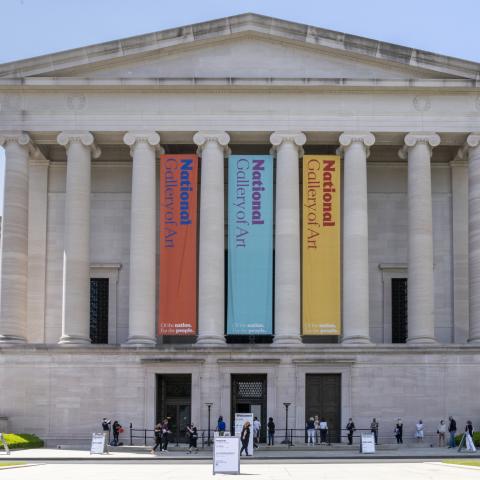Lady Mary Templetown and Her Eldest Son
1802
Sir Thomas Lawrence
Artist, British, 1769 - 1830

Like Reynolds and Romney before him, Lawrence preferred the "higher" genre of history painting but, through talent and necessity, became a portraitist. He was enormously successful in his own lifetime, was knighted in 1815, and elected president of the Royal Academy in 1820.
Although unschooled, Lawrence had a great natural gift for fluent linear rhythms and for the dramatic uses of light and color. Composed, gentle, and serene, Lady Templetown is a woodland goddess of otherworldly proportions. The purity and simplicity of the sitters' costumes draw the pair into a sympathetic unity that is further enhanced by the surrounding darker tones of the broadly rendered landscape. Lawrence animated the paint surface with accents of vibrant red in Lady Templetown's earrings and necklace, her son's cheeks, and in the landscape.
Lawrence's idealized presentation of his sitters in an expressive, theatrical landscape epitomizes the romantic style of portraiture. But Lawrence, like Reynolds, was also a passionate student of the classical past. His ideas on beauty were adapted from Aristotle's Poetics. He participated in the project that brought the Parthenon sculptures -- the Elgin marbles -- to England and owned a vast collection of old master prints.
More information on this painting can be found in the Gallery publication British Paintings of the Sixteenth through Nineteenth Centuries, which is available as a free PDF https://www.nga.gov/content/dam/ngaweb/research/publications/pdfs/british-paintings-16th-19th-centuries.pdf

West Building Main Floor, Gallery 59
Artwork overview
-
Medium
oil on canvas
-
Credit Line
-
Dimensions
overall: 215 x 149 cm (84 5/8 x 58 11/16 in.)
framed: 246.7 x 179.1 cm (97 1/8 x 70 1/2 in.) -
Accession Number
1937.1.96
Artwork history & notes
Provenance
Painted for the sitter's husband, John, 2nd baron (later 1st viscount) Templetown [1771-1846], Castle Upton, County Antrim; by descent to Henry, 4th viscount Templetown [1853-1939], Castle Upton; acquired c. 1890 by Baron Alfred Charles de Rothschild [1842-1918], London;[1] by inheritance to his illegitimate daughter, Almina Victoria, Countess of Carnarvon [c. 1877-1969], London; purchased 1923 by (Duveen Brothers, Inc., London, New York, and Paris); sold June 1923 to Andrew W. Mellon, Pittsburgh and Washington, D.C.; deeded December 1934 to The A.W. Mellon Educational and Charitable Trust, Pittsburgh; gift 1937 to NGA.
[1] The Rothschild provenance information was kindly provided by Michael Hall, curator to Edmund de Rothschild; see his "Rothschild Picture Provenances" from 1999 and letter of 27 February 2002, in NGA curatorial files, in which he cites relevant documents in The Rothschild Archive, London.
Associated Names
- Upton, John Henry, 1st viscount Templetown
- Upton, Henry Montagu, 2nd viscount Templetown
- Upton, George Frederick, 3rd viscount Templetown
- Upton, Henry Edward Montagu Dorington Clotworthy, 4th viscount Templetown
- Rothschild, Alfred Charles de
- Carnarvon, Almina Victoria, Countess of
- Duveen Brothers, Inc.
- Mellon, Andrew W.
- The A.W. Mellon Educational and Charitable Trust
Exhibition History
1802
Royal Academy of Arts, London, 1802, no. 5, as Portrait of Lady Templeton.
1979
Sir Thomas Lawrence 1769-1830, National Portrait Gallery, London, 1979-1980, no. 17, repro.
Bibliography
1799
Farington Diary, 5: 1759 (21 March 1802), 1773 (3 May 1802) and 6:2291 (7 April 1804).
1802
Monthly Mirror, 13 May 1802: 310.
Morning Chronicle, 3 May 1802.
True Briton, 3 May 1802, 2 June 1802.
1913
Armstrong, Sir Walter, Lawrence. London, 1913: 166.
1941
Preliminary Catalogue of Paintings and Sculpture. National Gallery of Art, Washington, 1941: 104, no. 96, as Lady Templeton and Her Son.
1942
Book of Illustrations. National Gallery of Art, Washington, 1942: 241, repro. 16, as Lady Templeton and Her Son.
1949
Paintings and Sculpture from the Mellon Collection. National Gallery of Art, Washington, 1949 (reprinted 1953 and 1958): 120, repro.
1954
Garlick, Kenneth. Sir Thomas Lawrence. London, 1954: 60, pl. 48.
1960
Cooke, Hereward Lester. British Painting in the National Gallery of Art. Washington, D.C., 1960 (Booklet Number Eight in Ten Schools of Painting in the National Gallery of Art, Washington, D.C.): 22, color repro.
1963
Walker, John. National Gallery of Art, Washington, D.C. New York, 1963 (reprinted 1964 in French, German, and Spanish): 320, repro., as Lady Templetown and Her Son.
1964
Garlick, Kenneth. "A Catalogue of the Paintings, Drawings and Pastels of Sir Thomas Lawrence." Walpole Society 39 (1964): 185, 306.
1965
Summary Catalogue of European Paintings and Sculpture. National Gallery of Art, Washington, 1965: 73, as Lady Templetown and Her Son.
1968
National Gallery of Art. European Paintings and Sculpture, Illustrations. Washington, 1968: 64, repro., as Lady Templetown and Her Son.
1975
European Paintings: An Illustrated Summary Catalogue. National Gallery of Art, Washington, 1975: 190, repro.,as Lady Templetown and Her Son.
Walker, John. National Gallery of Art, Washington. New York, 1975: no. 531, color repro.
1984
Walker, John. National Gallery of Art, Washington. Rev. ed. New York, 1984: 368, no. 517, color repro., as Lady Templetown and Her Son.
1985
European Paintings: An Illustrated Catalogue. National Gallery of Art, Washington, 1985: 222, repro.
1989
Garlick, Kenneth. Sir Thomas Lawrence: A Complete Catalogue of the Oil Paintings. Oxford, 1989: no. 760, repro.
1991
Kopper, Philip. America's National Gallery of Art: A Gift to the Nation. New York, 1991: 89, color repro.
1992
Hayes, John. British Paintings of the Sixteenth through Nineteenth Centuries. The Collections of the National Gallery of Art Systematic Catalogue. Washington, D.C., 1992: 156-158, repro. 157.
National Gallery of Art. National Gallery of Art, Washington. New York, 1992: 154, repro.
1998
Adler, Shane. “Whiteness." In Encyclopedia of Comparative Iconography: Themes Depicted in Works of Art. Edited by Helene E. Roberts. 2 vols. Chicago, 1998: 2:939.
Wikidata ID
Q20181439

